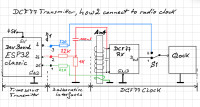DCF77 Signal Generator

An ESP32 mimics the DCF77 time signal server for DCF77 clocks in bad signal conditions.
Today, reception conditions for radio-controlled clocks are often very difficult. The widespread switching power supplies, LED-lighting, TV-sets and scattering DSL signals create an interference fog in which the time signals often disappear.
So why not simply replicate the missing signals yourself with a little computing power and internet-based time?
So why not simply replicate the missing signals yourself with a little computing power and internet-based time?
I have been working on generating time signals for professional GORGY clocks and other radio controlled DCF77 clocks for a while. At that time I googled C++ code snippets and was reasonably satisfied with my customised code compilation, but always dreamed of achieving the goal with ANNEX32-BASIC.
ANNEX version 1.70.1 and some great example BASIC codes from CiccioCB have now helped me over the hurdle.
ANNEX version 1.70.1 and some great example BASIC codes from CiccioCB have now helped me over the hurdle.
Now a simple ESP32 and a BASIC program with very few additional components can imitate the DCF77 time signal transmitter and control various clocks.
There are 3 signal outputs:
– Pin 25: 77.5kHz sine time signal with ~2Vpp, 100%/25% amplitude modulated
– Pin 26: 77.5kHz sine time signal with ~2Vpp, 100%/12.5% amplitude modulated
– Pin 2: Binary time signal, no carrier
These can be coupled to any radio-based DCF clock using one of three simple interface variants:
The ESP32’s waveform generator module is used, which outputs a sine wave signal from the two DACs purely based on hardware. Even the amplitude modulation can be done with this built-in generator. However, it requires the CW-generator hardware that is not included in all ESP32 variants but is included in the classic variant.
This make it possible to easily setup a DCF77 time signal generator with just the ESP32 a bit of software and no need for an external modulator stage etc.
– Pin 25: 77.5kHz sine time signal with ~2Vpp, 100%/25% amplitude modulated
– Pin 26: 77.5kHz sine time signal with ~2Vpp, 100%/12.5% amplitude modulated
– Pin 2: Binary time signal, no carrier
These can be coupled to any radio-based DCF clock using one of three simple interface variants:
The ESP32’s waveform generator module is used, which outputs a sine wave signal from the two DACs purely based on hardware. Even the amplitude modulation can be done with this built-in generator. However, it requires the CW-generator hardware that is not included in all ESP32 variants but is included in the classic variant.
This make it possible to easily setup a DCF77 time signal generator with just the ESP32 a bit of software and no need for an external modulator stage etc.
To cut a long story short: works very well and BASIC-based and I can send any time and date with very little HW effort.
My ANNEX32-BASIC code for any classic ESP32 Dev-Kit-board is attached as a txt-file , as I am currently not able to attache it here as <code>
I put a more elaborated post <here> including the highlighted BASIC code
My ANNEX32-BASIC code for any classic ESP32 Dev-Kit-board is attached as a txt-file , as I am currently not able to attache it here as <code>
I put a more elaborated post <here> including the highlighted BASIC code




Discussion (0 comments)